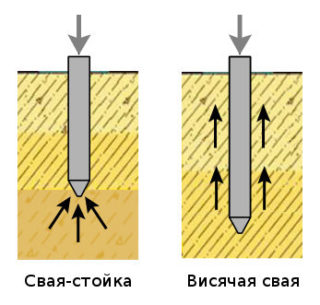For the construction of foundations for residential, administrative and utility buildings, various types of piles are used, each of which has a certain device, installation and operation features, its own advantages and disadvantages. In order not to be mistaken with the choice of elements for the support system, you should figure out what piles are, where and how they can be used, the nuances that should be taken into account when designing the construction of a house.
Definition of piles
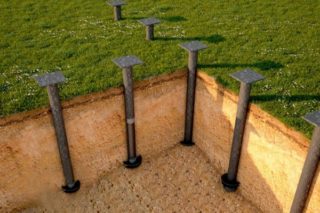
According to the technical definition, piles are solid longitudinal structures installed underground in order to create a support for objects erected from above for various purposes.
Supporting systems are subdivided according to the following parameters:
- method of immersion in the ground;
- material of manufacture;
- design features;
- length;
- size and type of section;
- the nature of the work;
- internal structure;
- terms of Use;
- life time;
- bearing capacity (tensile strength);
- reusability.
All types of foundation piles perform one function - they transfer the load from the structure to stable and durable soil layers, bypassing the weak structure with low bearing properties located on top.
Immersion classification and characteristics
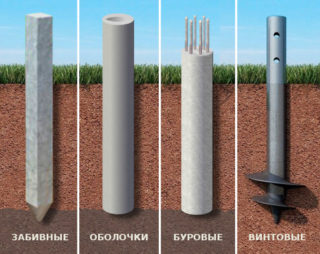
The main technical characteristic of the supports, which determines the choice for certain operating conditions, is the way they are immersed in the ground.
- Driving. They are characterized by increased strength and monolithic structure. Lowering is carried out under the influence of a hammer by driving in or pressing in with a powerful and heavy press.
- Shells. They are more often used in private construction, since they involve do-it-yourself installation. The technology is the production of a well, the immersion of the formwork into it, followed by the installation of the frame and pouring the cement mortar. The formwork can be fixed and reusable.
- Drilling. Installed in dry and hard soil. Concrete is poured into a hole made in the ground. Retention occurs by squeezing the walls or resting on a solid layer of soil.
- Screw. Products represent an analogue of a screw, which is screwed into the soil by a thread. The deepening can be carried out up to 20 m. There are blade and threaded types of screw piles, with welded, cast, closed and open tips.
The installation of the supports is carried out after conducting soil analysis, calculations and drawing up an installation diagram.
Pile classification and characteristics
- By the method of support on the ground. Hanging types of piles are held by friction arising from soil pressure against the side walls of the products. Used in dense and stable environments. The stanchions rest on firm soil below the soft and unstable substance.
- According to the material. Piles can be made from natural and artificial components. Steel products are smooth or bladed pipes with a diameter of up to 160 cm. Reinforced concrete supports are considered the strongest, most reliable and durable. They are characterized by large dimensions and heavy weight. Wooden ones are made from coniferous trees by giving the trunks a cylindrical shape.
- By the nature of the service.Monolithic and prefabricated products are used in construction. The connection can be made by couplings and welding, followed by concreting or insulation of the joint. After lowering, the support remains in its original form or is filled with concrete, as is the case with hollow products.
Before choosing piles, it is advisable to familiarize yourself with their manufacturer's description, purpose and installation method.
Types of pile foundations
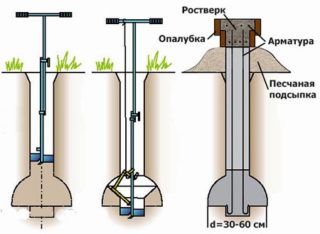
Supports are installed depending on the configuration of the building, soil characteristics and distribution of loads over the area and perimeter of the structure.
In construction and design, the following types of pile foundations are provided:
- Single posts. The technology involves the installation of single products in the corners of the house and in places of the strongest pressure.
- Group. A pile bush is installed under each column, which has a high bearing capacity and evenly transfers it to the ground.
- Tape. Supports are mounted in one or several lines, which are located at the same distance from each other. The pile field is made on weak and unstable soils, where the installation of other systems is impossible.
To reduce the specific ground pressure, the heel expansion technology can be used.
Pile driving
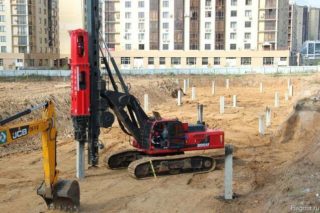
Driving is one of the ways in which supports made of wood or reinforced concrete are lowered into the ground.
This procedure is performed with special equipment of this type:
- pile hammers;
- vibrators;
- piling installations.
In the creation of the foundation, prefabricated and self-made piles can be used.
A feature of the technology is the complete immersion of products in the ground under the influence of a high vertical load. The substance located under and around the column is compacted and ensures its reliable fixation. The piles are very durable and are used in the construction of heavy high-rise and multi-storey structures of an industrial scale.
During the operation of the driven equipment, loud noise, strong vibration and ground displacement occur. This is fraught with partial or complete destruction of real estate objects located near the construction site. In addition, the supports require special storage conditions to prevent deformation.
Calculation of piles
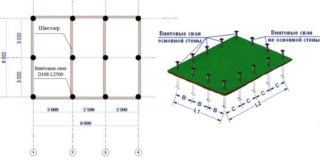
When calculating the type, number and layout of piles, the following indicators are taken into account:
- the total weight of the building with supporting structures, decoration, furniture, plumbing and household appliances;
- technical characteristics of supports, their purpose and design strength;
- characteristics of the soil, where the main thing is its bearing capacity.
After comparing the data, it remains to determine the total area of the required pressure on the soil and correlate it with the section of one support.
The scope of application of piles is limited by the financial side of the issue and the presence of monolithic rock formations on the site. Systems of this type are used to equip building foundations, supports for bridges, power lines, overpasses and other engineering structures. Piles have proven to be excellent for construction on rough terrain, at the bottom of reservoirs and as fortifying structures for unstable slopes.

